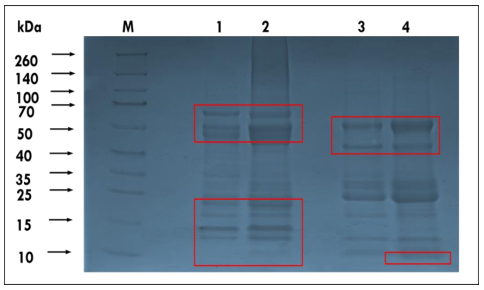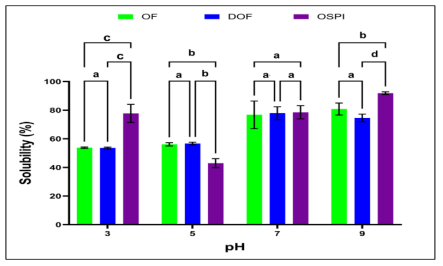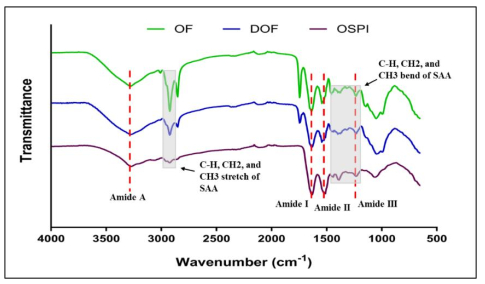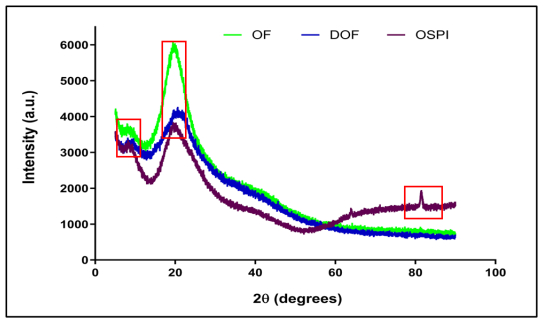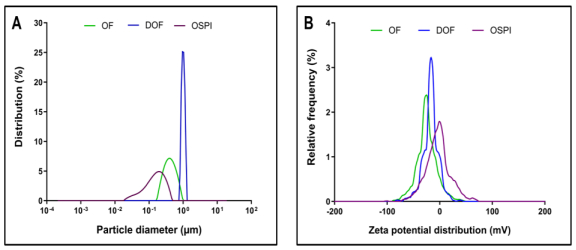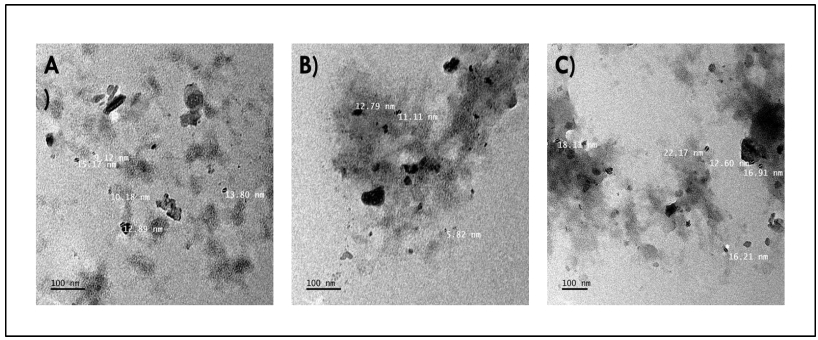1.
Introduction
Proteins are fundamental macronutrients that serve as building blocks of life, contributing significantly to the integrity and biological processes of organisms across humans, plants, and animals [1]. They regulate physiological pH, act as signaling molecules and hormones, are critical components of enzymes involved in metabolic pathways, support the immune system, serve as bioactive agents, and are integral to disease prevention [1]. Moreover, the functionality of proteins is affected by multiple intrinsic and extrinsic elements, including amino acid composition, protein structure, molecular size, extraction parameters, pH, and surface characteristics such as solubility. [2]. Proteins are macromolecules consisting of a linear sequence of amino acids linked by peptide bonds, influencing protein quality [3]. Plant-based proteins, in particular, exhibit distinct amino acid profiles, each contributing unique characteristics and potential health benefits. Plant-derived protein sources are becoming increasingly popular due to their environmental sustainability and cost-effectiveness [1].
This growing interest in plant proteins extends to their therapeutic potential [4]. Plant proteins have numerous health benefits, particularly in cancer treatments, where they demonstrate excellent tissue penetration, target selectivity, and minimal toxicity owing to their amino acid composition [5]. These proteins provide the essential amino acids our bodies need to repair tissues and synthesize enzymes, hormones, and other vital molecules [6]. Beyond their structural functions, plant proteins are instrumental in reducing the risk of numerous health conditions, such as heart disease, diabetes, and cancer [7,8]. The bioactivity of amino acids and peptides, influenced by factors like hydrophobicity and molecular charge, plays a fundamental role in determining their effectiveness in targeting specific diseases [9].
Plant proteins are derived from various sources, including legumes, pulses, vegetables, nuts, and oilseeds, such as chickpeas, Bambara groundnuts, and soybeans. According to [10], certain vegetables can also serve as natural therapeutic agents capable of treating a range of diseases, such as diabetes and hypertension. Abelmoschus esculentus, commonly known as okra or lady's finger, is a well-known angiosperm producing edible seed pods. Native to Africa but now grown commercially worldwide, okra thrives in warm temperate climates across tropical and subtropical regions of Africa, Asia, and America [11]. As a member of the Malvaceae family, okra has long been valued for its nutritional content and medicinal potential [11].
Historically, okra has served multiple purposes, including acting as a cooling agent, an appetizer, an astringent, and an aphrodisiac [12]. Furthermore, okra has traditionally been used to treat chronic dysentery and gonorrhea [13]. Okra seeds are rich in bioactive compounds, including proteins, and provide a wealth of fundamental vitamins and minerals, including vitamins C and potassium, vital for preserving wellness and immune function [14]. Okra has also proven effective in alleviating chronic illnesses such as diabetes [14]. Pharmacologically, okra demonstrates antioxidant and anti-inflammatory properties, with its polysaccharides, polyphenols, and flavonoids exhibiting both antioxidant and antifatigue activities in vivo and in vitro [14]. These compounds have increased the scavenging rates of free radicals, superoxide, and DPPH radicals and enhanced swimming endurance in test subjects (rat model) [15,16]. Okra seeds, aqueous extracts, and polysaccharides have also shown in vitro antidiabetic potential, decreasing α-glucosidase and α-amylase activities [17].
Moreover, okra polysaccharides demonstrate hypolipidemic activities, reducing cholesterol absorption and binding to bile acids [18], while methanol extracts of okra seeds display antibacterial and antifungal properties [19]. Additionally, ethanol extracts of okra and quercetin have shown in vitro immunomodulatory activity by decreasing reactive oxygen species and reducing microglial activation [20], along with okra polysaccharides having exhibited antitumor activity, enhancing phagocytosis in RAW264.7 cells [21]. Moreover, lectins from okra seeds have been reported to increase the expression of key genes such as P21, caspase 3, and caspase 9 involved in apoptosis [22]. While extensive research has explored the role of okra polysaccharides, polyphenols, and flavonoids in mitigating chronic diseases, the therapeutic potential of the okra seed protein isolate has yet to be discerned, despite it being a rich source of bioactive proteins.
2.
Materials and methods
2.1. Preparation of okra seed protein isolate
Okra seeds (ARC-okra24), sourced from the Agricultural Research Council (ARC), were milled to produce okra flour (OF). The resultant flour was sieved (250 μm) and defatted using hexane (1:5 w/v). The defatted okra flour (DOF) was subsequently utilized in the preparation of okra seed protein isolate (OSPI) with minor modifications, according to [23]. The DOF was mixed with distilled water (dH2O) (1:15 w/v) and stirred for 10 min. Then, the slurry's pH was adjusted to 10 using 1 M sodium hydroxide (NaOH). The slurry was stirred for 2 h, followed by centrifugation (10, 000 × g, 30 min). The resulting supernatant was adjusted to pH 4.5 using 1 M hydrochloric acid (HCL) and centrifuged (10, 000 × g, 30 min). The pellet obtained was resuspended in dH2O and adjusted to pH 7 using 1 M NaOH. The sample was stored at −80℃ for 24 h before lyophilization.
2.2. Protein
2.2.1. Protein content and yield
The protein content of OSPI was assessed using the Bradford protein assay, whereas the crude protein content of DOF was determined via the Kjeldahl method, applying a conversion factor of N × 5.30 [24]. The protein yield was then calculated using the following equation:
2.2.2. Protein solubility
Protein solubility was evaluated according to [25] with slight variations. In brief, 10 mg of the sample was dissolved in 10 mL of dH2O, and the pH was adjusted between 3 and 9 using 0.01 M NaOH or 0.01 M HCl. The suspension was vortexed (2 min, room temperature) and centrifuged (8000 × g, 15 min). The protein content in the supernatant was quantified using the Bradford method [24], and protein solubility was calculated using the following equation:
2.3. Chemical and structural composition
2.3.1. Amino acid composition
The amino acid profiles of the samples were analyzed in accordance with [26], using a Waters Acquity ultra-performance liquid chromatograph (UPLC). Amino acids were quantified either as free amino acids or after protein hydrolysis. Free amino acids were analyzed by injecting 1 µL of the sample into the mobile phase, which carried the derivatized amino acids onto a Waters UltraTag C18 column (2.1 × 50 mm × 1.7 µm) kept at 60℃. Protein hydrolysis was carried out through acid digestion with 6 M HCl. MassLynx software was used for instrument control and data acquisition.
2.3.2. Gel electrophoresis
Gel electrophoresis was used to determine the molecular weights of OSPI and OF under reducing and non-reducing conditions following the manufacturer's protocol. Briefly, 20 mL of Bolt™ MES SDS running buffer (20×) was diluted with 380 mL of deionized water and poured into the SureLock Tandem Midi Gel Tank. An Invitrogen™ precast gel (4%–12%) was placed in the tank. To prepare the samples, 10 mg of each was dissolved in 1 mL of phosphate-buffered saline (pH 7.4). Then, each sample (10 µL) was combined with 10 µL of Bolt™ LDS sample buffer (4×), and the volume was adjusted to 40 µL. For reducing conditions, 4 µL of Bolt™ reducing agent (10×) was added. The samples were heated (70℃, 10 min), and 15 µL was pipetted into each well. The Spectra™ Multicolor Broad Range Protein Ladder (10–260 kDa) was used as the molecular weight standard.
2.3.3. Infrared spectra analysis
The secondary structure of the samples was examined using an Agilent Cary 630 Fourier transform infrared spectrophotometer (FTIR) with a diamond-attenuated total reflectance (ATR) module, based on the method outlined by [27]. A resolution of 8 cm⁻¹ across a range of 4000–650 cm⁻¹ with 32 cycles of data collection was used.
2.3.4. X-ray diffraction (XRD)
XRD analysis of the samples was performed at the Council for Scientific and Industrial Research (CSIR) using a Bruker AXS D8 Advance powder X-ray diffractometer. The diffractometer was set to a tube current of 40 mA and a 45 kV generator voltage, following the modified method of [28], with some modifications. A fixed divergence slit (0.38 mm) and a copper anode were utilized.
2.3.5. Particle size and zeta potential
The particle size and zeta potential were determined using a Litesizer DLS 500 (Anton Paar) fitted with Kalliope software. Before evaluation, samples (1 mg/mL) were hydrated in dH2O for 1 h. The analysis was conducted at 25℃ with a solvent refractive index of 1.33 with minor modifications [29].
2.3.6. Microstructure analysis
Transmission electron microscopy (TEM) was used to analyze the microstructure (JEOL 2100 HRTEM, Japan) of OSPI at the Electron Microscopy Unit [University of KwaZulu Natal (UDW Campus)] as described by [30].
2.4. Statistical analysis
Analyses were conducted in triplicate, and the results are presented as mean ± standard deviation. Statistical significance for values with p < 0.0001 was established by means of a two-way analysis of variance (ANOVA), performed with GraphPad Prism 10 version 10.4.1 (627) for Windows (GraphPad Software, San Diego, CA, USA).
3.
Results and discussion
Amino acids (AAs) are the fundamental building blocks of life, playing a crucial role in maintaining optimal bodily function. They serve as precursors to secondary metabolic molecules with significant biological importance [31]. Amino acids can be classified as essential, which the body requires but cannot synthesize, non-essential, which the body can produce, and conditional, which are not crucial unless during illness [32,33]. Table 1 depicts the overall amino acid composition of the flours, which is lower than that of the protein isolate, likely due to the higher purity of the OSPI. Moreover, the protein isolate is higher than the Food and Agriculture Organization (FAO) recommendation, indicating its potential as a valuable nutritional source.
Leucine, known for enhancing muscle protein synthesis, is the principal essential amino acid in the samples, with OSPI showing the highest content at 6.56 g/100 g. This is slightly higher than a previous study's okra protein isolates and hydrolysate levels [34]. Moreover, among the non-essential amino acids, glutamic acid (14.46 g/100 g), which may include glutamine and arginine (9.42 g/100 g), was prominent in OSPI, aligning with the results found by [34] and [23]. Glutamine and arginine are also conditional amino acids essential in regulating immune response and neurotransmission, improving endothelial function, and preventing cardiovascular disease [35]. In addition, [36] elucidated that arginine could penetrate and disrupt cell membranes, leading to cytotoxic effects in cancer cells, further emphasizing the therapeutic potential of OSPI. Furthermore, aspartic acid, which may include asparagine, was notably present at 7.56 g/100 g. [37] also attributed antiproliferative activity in tumor cells to a combination of aspartic and glutamic acids. These findings highlight the potential of OSPI in disease prevention, particularly in cancer therapy.
OSPI also exhibited a significantly high content of hydrophobic amino acids (HAAs), totaling 31.39 g/100 g, consistent with the findings of [34] for okra protein isolate and hydrolysate. [38] noted that food-derived HAAs could facilitate immunomodulatory activity and enhance the specificity of target cells for potential anticancer therapeutics, further underscoring the therapeutic potential of OSPI. Moreover, proteins with higher levels of branched-chain amino acids (BCAAs) compared to aromatic amino acids (AAAs) are beneficial for health, with applications in antitumor activity and liver damage repair [39]. OSPI exhibited a BCAA content of 14.24 g/100 g, almost double that of the AAA content, emphasizing its pharmaceutical potential. The presence of these significant amino acids, combined with the high HAA content, suggests the bioactive potential of OSPI for therapeutic applications.
The molecular weight of proteins is crucial in determining their bioavailability and bioactivity [34], as the size of the bioactive peptides within proteins influences their bioavailability [41]. Under non-reducing conditions, the samples exhibited three prominent high-intensity polypeptide bands (Figure 1) around 55, 64, and 75 kDa (lanes 1 and 2). The 55 and 64 kDa bands correspond to vicilin (7S globulin) subunits, which are predominantly found in legume proteins and have been observed in protein isolates from Bambara groundnut and hyacinth beans [29,42]. The protein band around 75 kDa represents convicilin, the α-subunit of vicilin [29].
The low-molecular-weight bands for the samples (lanes 1 and 2) between 10 and 20 kDa, which are associated with basic legumin (11S globulins), were observed under non-reducing conditions. The polypeptide band at 20 kDa corresponds to studies conducted by [42] and [29] for hyacinth bean and Bambara groundnut protein isolates, respectively. Moreover, nanoparticles derived from legumin and vicilin proteins of fava beans have shown promise as encapsulation materials for nutraceutical compounds, demonstrating biocompatibility with CaCo-2 cells and efficient nutrient delivery [43]. This highlights the potential of legumin and vicilin as effective drug delivery carriers, further supporting the therapeutic potential of OSPI, as both proteins are abundant in OSPI and serve as rich sources of bioactive peptides.
However, [44] inferred that protein bands < 20 kDa correspond to 2S albumins. 2S albumins are low-molecular-weight proteins characterized by a high concentration of glutamine, arginine, and asparagine [45]; the predominant amino acids present in OSPI are associated with numerous health benefits, as previously stated. Additionally, 2S albumins exhibit numerous biological advantages, such as being an antibacterial agent that can limit and prevent pathogenic bacteria's progression in humans [46]. In a study by [47], 2S albumins derived from sesame seeds demonstrated strong inhibitory effects against Klebsiella species, a gram-negative bacterium responsible for pneumonia and other infectious diseases. The biological activities exhibited by 2S albumins suggest significant potential for development as antibiotic agents [45]. Therefore, the presence of 2S albumins in OSPI underscores its potential in therapeutics.
Under reducing conditions, lanes 3 and 4 revealed fewer polypeptide bands with a downward shift, which were observed with a band at 14 kDa absent. This suggests the presence of disulfide bonds in the non-reduced state of the samples [42]. A polypeptide band at 48 kDa is observed in both OF and OSPI under reducing conditions, corresponding to the β-conglycinin subunit present in soybean protein isolates [48]. This subunit has been demonstrated to decrease cholesterol levels and influence obesity, highlighting the therapeutic potential of OSPI [49]. Moreover, the protein isolate denotes a band of 9 kDa under reducing conditions. In a previous study [48], protein fractions between 5 and 10 kDa and > 10 kDa from germinated soybean protein exhibited high potency in inhibiting the proliferation of CaCo-2 cells. Furthermore, soybean peptides with molecular weights > 10 kDa effectively inhibited breast and cervical cancer growth [50]. The protein bands at 9, 10, and > 10 kDa in OSPI highlight its potential for application as a pharmaceutical agent. Additionally, no significant differences can be observed between OF and OSPI under both conditions.
The solubility of proteins aids in determining their functionality and can be impacted by pH and amino acid composition [2]. Poor solubility can affect the bioavailability of proteins and its therapeutic efficiency. As depicted in Figure 2, both flours showed no significant differences within the pH range of 3–9. Overall, the protein solubility of the flours increased at each pH unit, exhibiting the highest solubility in the alkaline region, except DOF at pH 9 (74.52%). The protein isolate exhibits a similar trend to the flours, showing the highest solubility (91.86%) among the samples at pH 9. Additionally, OSPI was shown to be the least soluble at pH 5 near the isoelectric point. This is likely due to protein precipitation caused by the absence of a net charge on the molecules and can also indicate variations in the surface structure of proteins [4,51]. Moreover, comparable findings were discerned for sunflower protein isolate, which was insoluble between pH 4 and 5.5 and gradually increased to pH 7 [52]. A study on four soybean cultivars was comparable to the results achieved for OSPI, exhibiting minimum solubility around pH 5 [51]. According to [53] and [51], the low solubility of proteins near the isoelectric point could indicate β-conglycinin found in soybean protein. Moreover, as established in the molecular weight profile, β-conglycinin was identified in OSPI with potential health benefits. Thus, the low solubility of OSPI near pH 5, corresponding to the β-conglycinin subunit, further emphasizes its therapeutic potential. The amino acid composition of samples differs, therefore displaying varying degrees of solubility as the different charged groups (polar and non-polar) affect the solubility of the samples [54], as indicated by the deviation in results.
The high solubility of OSPI suggests increased bioavailability for its application as a potential therapeutic agent. This potential is underscored by a study conducted by [55] in which a widely used chemotherapeutic agent, docetaxel (DTX), was combined with soy protein isolate (SPI). The results indicated that the inclusion of SPI notably improved the solubility of DTX within a pH range of 7–10 [55]. Furthermore, the DTX-SPI suspension indicated a systolic delivery, which, in turn, supplemented the cell cytotoxicity against A549 cells (lung cancer). This study not only validates the high solubility of OSPI but also highlights its ability as a delivery and pharmaceutical agent against diseases such as cancer, particularly given its high solubility at an alkaline pH.
The FTIR spectra (Figure 3) depict no significant shifts in wavenumbers among the samples. Protein-containing samples display nine distinct spectral lines within the absorption range of approximately 200–3300 cm⁻¹ [56]. These bands result from various oscillatory modes of the amide groups present in peptide bonds and are classified as amides A, B, and Ⅰ–Ⅶ. Various characteristic peaks related to proteins were observed. The peak at 1636.30131 cm-1 for the flours and protein isolate indicates amide Ⅰ, corresponding to results achieved by [44] for quinoa protein. The amide Ⅰ band is primarily associated with the stretching vibrations of C = O bonds in the peptide backbone and is widely recognized as the most sensitive and commonly used band for analyzing protein secondary structures [56]. Moreover, the proportion of each protein secondary structure can be determined by examining the area under the peaks in the original spectra, which are ascribed to specific structural components [56]. The amide Ⅰ peak is positioned between 1628 and 1642 cm-1 on the infrared spectrum, which is typically attributed to β-sheet structures [56,57].
Amide Ⅱ is usually denoted in the region of ∼1500 to ∼1550 cm–1, as described by [44] and [27], respectively. Thus, the bands found at 1543.11786 cm–1 in the flours and 1524.48118 cm–1 in the protein isolate link to results of quinoa protein [44] and in pulse proteins such as chickpeas [27]. An estimated peak fitting proposes that the flours are positioned within the range of 1540–1545 cm–1, suggesting an association to α-helical structures, while the protein isolate is located between 1520 and 1525 cm−1, correlating to β-sheet secondary configurations [56,58].
Additionally, identifying protein secondary structure bands is further challenged by the absorption of amino acid side chains within the protein [56]. This absorption overlaps with the amide Ⅰ and Ⅱ bands, accounting for approximately 10%–20% of the total absorption in these regions for globular proteins [56,59]. Furthermore, [56] elucidated that aromatic amino acid side chains also influence the spectrum in the amide Ⅰ and Ⅱ regions; in particular, amides Ⅰ and Ⅱ lie closest to arginine at 1633 cm−1 on the spectra and are associated with C = N symmetric stretching. As previously mentioned, arginine was one of the primary amino acids in OSPI and presented numerous associated therapeutic benefits. Thus, identifying amide bands further emphasizes the potential of OSPI as a therapeutic agent.
A peak at 1233.74882 cm–1 was noted in OF and at 1230.02149 cm–1 in DOF and OSPI. These band frequencies allude to amide Ⅲ, similar to quinoa protein at ∼1200 cm−1 [44]. Moreover, [27] showed that lentil protein amide Ⅲ lays between 1232 and 1470 cm-1, representing C-H, CH2, and CH3 bends of sulfur-containing amino acids SAA. C-H, CH2, and CH3 stretches were identified as lentil proteins in all samples at 2922.23286 cm–1. These stretches were observed between 2826 and 2995 cm–1, signifying SAA [27]. Whilst the peak at 2922–23286 cm–1 reflected in all the samples, OF showed a long, narrow peak, whereas the peak in DOF appeared shorter and more stretched, and OSPI emerged flatter and more expansive. In addition, a broad peak attributed to amide A was observed in all samples. OF was depicted at 3276–32996 cm–1, and a slight shift in wavenumber to 3272–60262 cm–1 denoted DOF and OSPI. These results correlate with quinoa protein (amide A: 3270–3310 cm–1) [44].
The size of a crystal influences the diffraction angle (2θ) and intensity [28]. Moreover, these factors are crucial for understanding potential conformational changes within protein structures and their interactions with other molecules [28]. Smaller crystals produce lower diffraction intensities and broader diffraction angles [28]. The diffraction peak around 7° indicates crystalline region Ⅰ, while the peak shoulder near 2θ = 19° represents crystalline region Ⅱ (Figure 4) [28]. These peaks are comparable to alfalfa and sunflower protein isolates in which the broad band around 2θ = 20° was ascribed to the amorphous nature of the protein [28,60]. This thus suggests that the peak at 2θ = 19° in OSPI could indicate the amorphous nature of OSPI. According to [61], proteins with amorphous structures benefit therapeutics as they offer a higher dissolution rate and enhanced bioavailability for drug development, suggesting that OSPI could serve as a promising pharmaceutical agent. Additionally, the differences in peak intensity may result from the varying interactions between protein molecules and polyphenols [28].
The prominent diffraction peaks in both regions Ⅰ and Ⅱ correspond to the reflections of 7S (α-helix) and 11S (β-sheet) globulins, respectively, within the polypeptide chain structure, as identified by gel electrophoresis [62]. Furthermore, OSPI displayed a minor peak around 81°, similar to soybean protein isolate, which has previously shown an affinity for vitamin D encapsulation [63], further highlighting the therapeutic potential of OSPI. Additionally, the minor peak shows low intensity and a broad angle, which alludes to OSPI being smaller in size.
The polydispersity index (PDI) indicates particle size distribution and uniformity [64]. PDI values of 0.1–0.25 denote a narrow distribution of particles, while a broad distribution is indicated by values greater than 0.5 [64]. OF and OSPI were shown to have PDI values of 2.2 and 2.7, respectively, aligning with a wide distribution. DOF showed a PDI value of 0.22, corresponding to a narrower distribution, suggesting particle monodispersity. Moreover, [65] highlighted that particle size and PDI could impact drug delivery, cellular uptake, and encapsulation efficiency, directly affecting therapeutic outcomes. As shown in Figure 5A, the samples depicted a monomodal distribution. OSPI appeared the smallest at 0.144 ± 0.1 µm, compared to OF and DOF, which reflected at 0.433 ± 0.2 µm and 1.37 ± 0.1 µm, respectively. The small size of OSPI suggests its potential as a long-circulating carrier, ideal for drug delivery to tumors, while OF and DOF are better suited for transdermal and intravenous administration, respectively [65]. The applications mentioned above emphasize the pharmacological potential of OSPI.
The zeta potential, which represents the surface charge of a protein, is a vital factor in its stability, functionality, and interactions within biological systems. Understanding this property for therapeutic applications is essential, as it influences protein behavior, including solubility, aggregation tendency, and interactions with cells or tissues [66]. A zeta potential above ± 30 mV is typically considered stable [67]. As illustrated in Figure 5B, OSPI exhibited the highest stability with a zeta potential of −29.7 ± 2.6 mV, compared to OF and DOF, which had zeta potentials of −27.5 ± 1.1 mV and −25.0 ± 0.6 mV, respectively. The zeta potential of OSPI was similar to that of soybean protein, as reported by [51]. Moreover, [68] noted that exosome-like nanovesicles derived from plants, with surface charges of −14.8 mV and −15.2 mV, proved effective as encapsulation materials for therapeutic drug delivery to human cells. This suggests that OSPI, with its higher stability, could be efficiently utilized in drug delivery applications.
Transmission electron microscopy (TEM) can be used to identify and characterize the microstructure of proteins [69]. Figure 6 depicts the TEM of the flours and protein isolate particles. OF and DOF had median sizes of 12.2 nm and 9.9 nm, respectively, while OSPI showed an average size of 17.2 nm. The hydrodynamic diameter obtained from particle size analysis showed an inverse correlation with the TEM analysis, which revealed smaller sizes. The smaller sizes observed by TEM could be attributed to differences in sample state during analysis [30], as the particle size samples are hydrated, potentially increasing the average particle size. The particle sizes suggest that these samples could be suitable for drug delivery via the reticuloendothelial system, allowing for deposition in various organs throughout the body [65]. Furthermore, the particles displayed a near-spherical shape with a smooth surface, which are key characteristics contributing to effective drug delivery [70], owing to OSPI's potential in therapeutics.
4.
Limitations and future perspectives
Although okra seed protein isolate (OSPI) exhibits promising therapeutic potential, there are limitations to the research. This research fundamentally focuses on in vitro analyses, which may not fully replicate in vivo conditions, hypothetically limiting the direct clinical applicability of the results. Additionally, factors such as protein solubility, bioavailability, and stability under physiological conditions require further investigation to ensure effective therapeutic delivery. The presence of hydrophobic amino acids and low-molecular-weight peptides suggests potential bioactivity; however, their specific mechanisms of action and pharmacokinetics remain to be elucidated. Future research should explore in vitro and in vivo validation using cell culture and animal models to confirm the therapeutic efficacy of OSPI. Furthermore, exploring the synergistic effects of OSPI with other bioactive compounds for enhanced solubility and bioavailability, possibly through nanocarrier systems, could improve its pharmaceutical applications.
5.
Conclusions
This study highlights the therapeutic potential of okra seed protein isolate (OSPI), emphasizing its rich amino acid composition, structural properties, and bioactive potential. OSPI exhibited an essential amino acid profile higher than FAO recommendations, with notable leucine, glutamic acid, arginine, and hydrophobic amino acid content. These amino acids contribute to immune regulation, neurotransmission, cardiovascular health, and anticancer activity, reinforcing OSPI's potential for disease prevention and treatment. The study also confirmed OSPI's high solubility, particularly in alkaline conditions, which enhances its bioavailability and functional properties. Electrophoresis revealed the presence of 7S and 11S globulins, along with 2S albumins, known for their antibacterial and immunomodulatory properties. Additionally, FTIR analysis confirmed the presence of key amide bands associated with secondary protein structures. At the same time, XRD data indicated an amorphous nature beneficial for pharmaceutical applications due to increased dissolution and bioavailability. The small particle size and monodispersity of OSPI suggest its suitability for drug delivery systems, while its polydispersity index (PDI) indicates the potential for encapsulation efficiency. These findings collectively underscore OSPI's potential as a functional protein with applications in therapeutic formulations, particularly in cancer treatment, antimicrobial agents, and nutraceuticals. Further studies on its bioactivity in complex biological systems could pave the way for its integration into the pharmaceutical and functional food industries.
Author contributions
Letisha Maistry: Writing-original draft, Data curation, Formal analysis; Abe Shegro Gerrano: Writing-review and editing manuscript, Supervision; John Mellem: Conceptualization, Funding acquisition, Resources, Supervision, Writing-review and editing manuscript. All authors have read and agreed to the published version of the manuscript.
Use of AI tools declaration
The authors declare they have not used Artificial Intelligence (AI) tools in the creation of this article.
Acknowledgments
The authors would like to acknowledge the Durban University of Technology (Kwa-Zulu Natal, South Africa) and the National Research Foundation [Grant # 735336] for support.
Conflict of interest
All authors declare no conflict of interest.









 DownLoad:
DownLoad:
